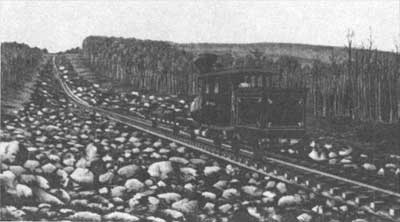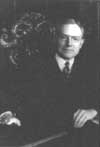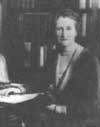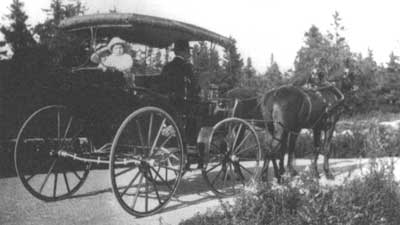 | ||
 | ||
 | ||
 | ||
 | ||
 | ||
 | ||
 | ||
 | ||
 | ||
 | ||
 | ||
 | ||
 | ||
 | ||
 | ||
 |
 |
 |
Acadia Roads and Bridges
Acadia National Park, Maine

Early tourist transportation on Mount Desert Island included this cog railway, which climbed the slopes of Cadillac (Green) Mountain in the 1880s. The owner dynamited the carriage road to promote business. (postcard courtesy of BHHS) |
CARRIAGE ROADS FOR "COTTAGES"

John D. Rockefeller, Jr. (RAC) |
With the rise of the automobile during the final decades of the nineteenth century, the beauty of Mount Desert Island became increasingly accessible to tourists. Sensing an economic opportunity. some residents promoted road construction as a means of drawing visitors to the island. In 1888, for example, locals built a road to the shore of Eagle Lake in an effort to promote the island as a vacation destination. Other islanders were less enthused. Summer resident John D. Rockefeller, Jr., whose family fortune resulted from the Standard Oil Company, ironically saw the increase in the number of cars as a threat to his idyllic island getaway. In reaction to this symbol of urban industrial society, he constructed carriage roads for horse and foot traffic only. By 1941 he had built more than forty miles of such roads throughout the east side of the island. The first roads were built on his Seal Harbor estate; later roads were constructed on park lands, or land which Mr. Rockefeller acquired and later turned over to the park.

Beatrix Farrand (DORL) |
In building the carriage roads, Rockefeller went to great lengths to ensure their aesthetic character. He personally oversaw much of their construction and hired landscape gardener Beatrix Farrand to recommend roadside plantings to hide unattractive scarring. Along with the beauty of the roads themselves, Rockefeller was equally concerned with the scenery they exhibited. He consciously designed his carriage routes to present the users with a sequence of scenic experiences, including views across meadows, alongside streams, and from mountain tops. The desire to build roads that complemented their natural surroundings is perhaps best illustrated by Rockefeller's stone carriage road bridges. Each was painstakingly constructed from native materials that allowed the bridges to blend in with the natural landscape. Many were designed to provide scenic vistas or places for rest and contemplation.
"I suppose that you appreciate the fact that well-built roads are the most durable works of man. They outlast all other structures and monuments."
— Charles Eliot to John D. Rockefeller, Jr., 1916

The Rockefeller family touring the carriage roads, 1917. (RAC) |
| Introduction | Acadia | Blue Ridge Parkway | Colonial Parkway | Generals Highway | George Washington Memorial Parkway | Great Smoky Mountains | Mount Rainier | Rock Creek and Potomac Parkway | Shenandoah's Skyline Drive | Southwest Circle Tour | Vicksburg | Yellowstone | Yosemite | Discover History |
